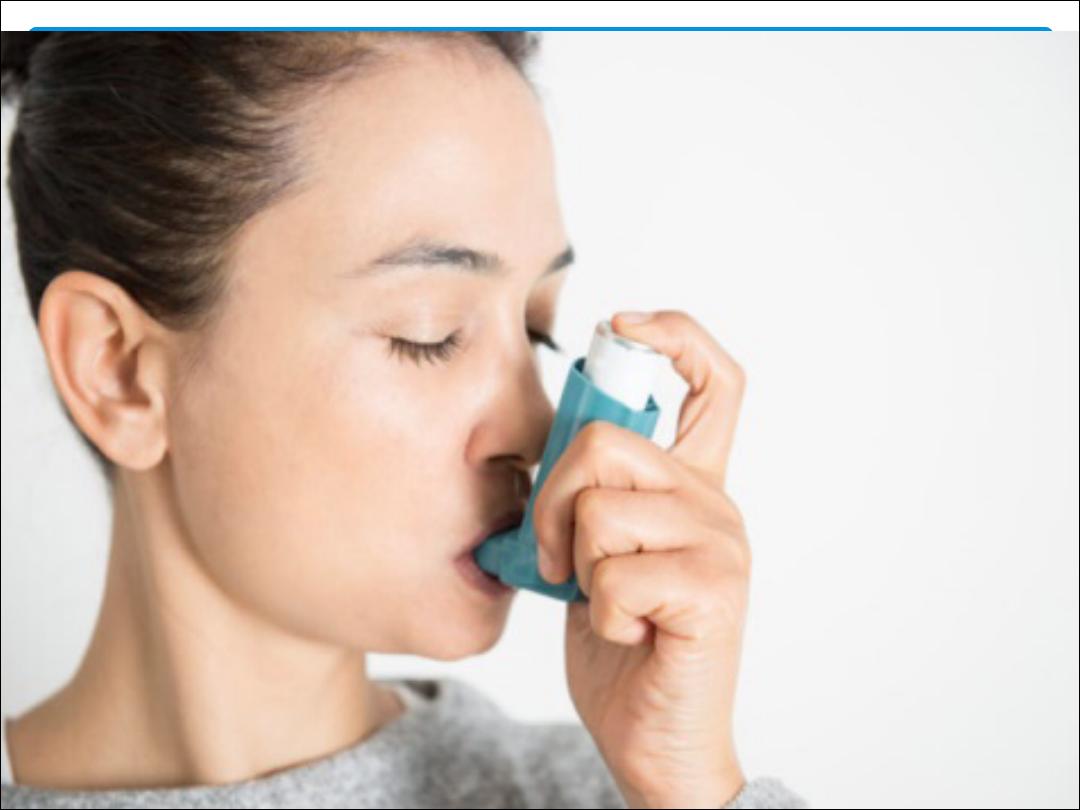
ا
ﻻ
ﺳ
ﺎﺗ
ذ
ا
دﻟ
ﻛ
ﺗ
و
ر
ﻋ
ﻼ
ء
ﺣ
ﺳ
ﯾ
ن
ﺣ
ﯾ
د
ر
ﻟا
ﺣ
ﻠ
ﻲ
Asthma

*
1- To know the etiology of asthma
2 -To understand the pathophysiology of asthma
3- To know the clinical pictures of asthma
4- To know how to diagnose asthma
4- To know the lines of treatment
5- To know how to deal with exacerbation of the disease
Objectives

*
Asthma is a chronic inflammatory disorder of
the airway associated with airway hyper
responsiveness with recurrent episodes of
wheezing , breathlessness, chest tightness
and coughing particularly at night and early
morning.
It affects all age groups.
The prevalence of asthma increases in the last
century
Definition

*
Airway hyper-reactivity ( the tendency of airway to narrow in
response to tigers that have little or no effect on normal
individuals) is the integral to the diagnosis of asthma . The relation
ship between atopy ( the ability to produce IgE ) and asthma is
well established , common examples of allergens include house
dust mite , pets such as cats and dogs , pests such as cockroaches,
and fungi . Inhalation of allergen into the airway is followed by
early and late bronchoconstriction response . In cases of aspirin
sensitive asthma , the ingestion of salicylates results in inhibition of
cyclo-oxygenase enzyme with production of asthmogenic
substance . In exercise induced asthma, hyper ventilation results in
water loss from bronchial tree which in turn trigger mediatory
release . In persistent asthma , a chronic and complex
inflammatory response occurs with influx of many inflammatory
cells .With increasing severity and chronicity there will be fibrosis of
airway with poor response to bronchodilator medication
Pathophysiology

*
Typical symptoms include wheezing , chest tightness ,
breathlessness and cough ( it may be misdiagnosed as
prolonged chest infection ) . Wheezing some times can
not found on exam . cough may be dominant symptom
with lack of wheeze and breathlessness ( cough variant
asthma ).
Precipitating factors include exercise, exposure to cold
weather , exposure to air born allergen or pollution and
upper respiratory infection . Some times asthma is
triggered by medications ( such as B blockers , aspirin and
other non steroidal anti inflammatory drugs ( aspirin
sensitive patients occur more in female with rhinsinusitis
and nasal polyp )
*
Clinical features

*
Patients with intermittent asthma are free from
symptoms between the attacks while persistent
asthma they have ongoing symptoms that vary in
severity over the day or from day to day and month to
month. Asthma typically causes diurnal variation in
symptoms more early in the morning.
Careful history needs to be taken regarding presence of
eczema , nasal polyp, blocked nose , sinusitis… etc
that can be associated with asthma. Careful history
needs to be taken to know causative agents that
precipitate asthma .
Factors triggering asthmatic attack include 1- allergen 2-
respiratory tract infection 3- exposure to cold 4-
exercise 5- emotional stress 6- exposure to chemical
substances ( occupational asthma ) 7- exposure to
some drugs ( like aspirin and B drugs )

*
The patient put his chest on full inspiration with usage od accessory
muscle of respiration, hype resonance on percussion notes and
there is inspiratory and expiratory rhonchi with prolongation of
expiratory phase . In acute severe asthma we may get no rhonchi (
because of little amount od air enter the airway ) and this is serious
condition called silent asthma.
Investigations including CxR is not done routinely except in severe
form . Shows no abnormal signs apart from hyperinflation . In acute
severe asthma not responding to treatment CxR needs to be done to
exclude pneumothorax , pneumonia or development of lung collapse
because of mucous plug . Arterial blood gases initially shows hypoxia
and hypocapnea due to hyperventilation and the PH decreases due to
development of respiratory alkalosis , finding of normal or increasing
Paco2 is bad sign reflecting that the patient starts to hypo ventilate
and passing to type 2 respiratory failure
Physical signs

*
The diagnosis of asthma is based on clinical presentation
plus lung function and other tests . spirometry ( by
measuring FEV1and FVC is useful to demonstrate
obstructive defect , shows its severity and shows
response to bronchodilator therapy ( increase FEV1 more
than 12% following bronchodilator or more than 15%
decrease after 6 minutes of exercise support the
diagnosis) . If spirometry not available, peak flow meter
can be used ( recorded before going to sleep and at early
morning , needs to get decrease 20% early morning ).
Atrial of steroid 30 mgs for two weeks that show
improvement in FEV1 or peak expiratory flow rate is also
helpful in the diagnosis .
diagnosis

*
The pulmonary function test can be normal in
asthmatic patients between the attacks and
theses patients may require challenge test to
demonstrate symptoms and lung function
abnormality. Presence of atopy can be
demonstrated by skin prick test or by
measurement of total and allergen specific IGE.
Chest x-ray is usually normal or hyper inflated but
may show collapse ( if mucous occludes bronchus )
or chest infection ( pneumonia ) .

*
Asthma is a chronic disease and the aim of treatment is to
get optimal control.
*
Avoidance of aggravating factors :
Many asthmatic patients are sensitive to multiple allergens
making avoidance difficult , any how this can be applied by
avoidance of relevant allergen like pet , house dust mite
exposure may be reduced by changing carpets by floor
boards, measures to decrease exposure to fungi can be
applied , avoidance of medication that precipitate asthma,
avoidance of smoking is important for smoking encourage
sensitization and induces relative glucocorticoid
resistance
Management

*
Hypo sensitization :
*
This includes subcutaneous injection of
substance derived from the allergen and
increasing it gradually but this therapy is not
with out risk of anaphylaxis .

*
Step 1 – Occasional use of inhaled short acting B2 adrenoreceptor
agonist bronchodilator :
*
including inhaled salbutamol or terbutaline inhalers used for mild
asthma ( symptoms less than once a week and less than two
nocturnal symptoms per month ) .
Step 2 – Introduction of regular preventer therapy :
Used if the patients reports symptoms three times a week and more ,
uses inhaled B2 three times a week and more ,awaken one night a
week due to asthma and if he gets exacerbation of asthma in the last
2 years . Treatment include in addition to inhaled B2 agonist ,use of
inhaled glucocorticoid like beclometasone ( 400 micro g ) ,
budesonide, fluticasone …etc ,other anti inflammatory include
chromones , leukriene antagonist and theophylline ( much less
effective )
The stepwise approach


*
Step 3 – Add - on therapy :
*
If patients remain poorly controlled we use the addition
of long acting B2 agonist to an inhaled glucocorticoid
such as combination of formoterol and budesonide and
we need to check for ongoing exposure to ppt factors
and adherence. Oral leukotriene receptor antagonist is
less effective than long acting B2 agonist but can be
added to decrease dose of inhaled glucocorticoid . In
patients using high dose inhaled steroid he may get
oropharangeal candiasis and to prevent it patient needs
to rinse and spit
drug:
th
Addition of 4
-
Step 4
Inhaled glucocorticoid can be increased to 2000 micro g ,
addition of leukotirene receptor antagonist or theophylline
orally or oral slow release B2 agonist or addition of inhaled
anticholinergic like ipratropium bromide

Step 5- Continuous or frequent use of oral glucocorticoid :
At this stage if patient continues to have symptoms we add
oral steroid preferably in the morning in the lowest dose
able to control symptoms . If patient continues to have
symptoms we may use monoclonal antibody such as
omalizumb or mepolizumb . Use of immunosuppressant is
less common nowadays because of their little effect and
their side effects.
Step down therapy:
Once the symptoms had been controlled , the dose of
inhaled glucocorticoid should be titrated to the lowest dose
that control the symptoms and trial to get step down

*
Exacerbation is precipitated usually by viral infection or exposure
to moulds or pollens or air pollution , usually occurs over few hours
but some occur with out warning ( brittle asthma ).
Management of mild to moderate exacerbation :
Treatment is by rescue dose of glucocorticoid (prednisolone 30 to 60
mg daily ). Tapering the dose is only required if it is given more than 3
weeks. Indications for this treatment include 1- worsening of
symptoms with decrease in PEF less than 60% of the patient best
recording 2-sleep disturbance 3- persistent of morning symptoms till
mid day 4- decreasing response to inhaled bronchodilator 5-
development of symptoms require treatment with nebulized or
injected bronchodilator
Exacerbation of asthma

Management of acute severe asthma :
Features of acute severe asthma include 1- PEF is 33-50% predicted
(less than 200 Liter per minute )2-heart rate more than 110 3-
respiratory rate more than 25 breaths per minute 4- Can not complete
sentence in one breath
The patient usually assume sitting position to help breathing by fixing
shoulders and may get pulsus paradoxus.
Features of life threatening asthma include 1-PEF less than 33%
predicted 2- Spo2 less than 92% or Pao2 less than 8 kPa 3- normal or
raised Paco2 4- Silent chest 5-Cyanosis 6- Brady cardia or arrhythmia 7-
hypotension 8- exhaustion 9- delirium 10- coma
Features of near –fatal asthma include raised Paco2 and or require
mechanical ventilation

Treatment includes the following measures
1- High oxygen concentration to keep oxygen saturation above 92%.
Failure to achieve this is indication for assisted ventilation
2- High dose of inhaled short acting B2 agonist ( like salbutamol 2.5- 5
mg or terutaline 5- 10 mg ) better given through nebulizer can be
repeated every 15- 20 minutes . Ipratropium bromide ( 0.5 mg can be
repeated every 6 hours ) provides further bronchodilation and can be
added to salbutamol
3- Systemic glucocorticoid orally as prednisolone (30-60 mg)or
intravenous hydrocortisone ( 200 mgs ).
Many patients are dehydrated probably due to hyper ventilation
associated with high insensible water loss and need intravenous fluid
Potassium supplement may be required as repeated doses of
salbutamol may result in hypokalemia

*
If patient not respond , intravenous magnesium provides
additional bronchodilation. Some patients benefit from intravenous
aminophylline ( 250 mg over 20 minutes then 0.5-0.9 mg per kg
every hour ) but cardiac monitoring is recommended because it
may cause cardiac arrhythmias .
Maintenance therapy include 1- use of hydrocortisone 200mg
intravenously every 6 hours, continue salbutamol nebulizer every 4
hours or ipratropium every 6 hours and can keep the patient on
continuous aminophylline drip 0.5- 0.9 mg per kg hourly with close
cardiac monitoring
Indication for assisted ventilation in acute severe asthma :
1- coma 2- respiratory arrest 3- deterioration of arterial blood gases
(Pao2 less than 8 kPa (60 mmHg)or Paco2 more than 6kPa(45 mmHg)
or PH low and falling 4- exhaustion , delirium and drowsiness

*
The out come of acute severe asthma is
good although death can occur( failure
to recognize severity is an important
cause of deterioration and death) .Prior
to discharge patient needs to be stable
and not require nebulizer for the last 24
hours . We should look , know and avoid
trigger.
Prognosis
